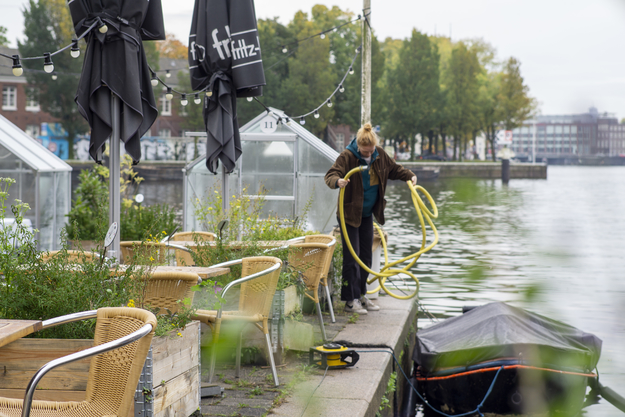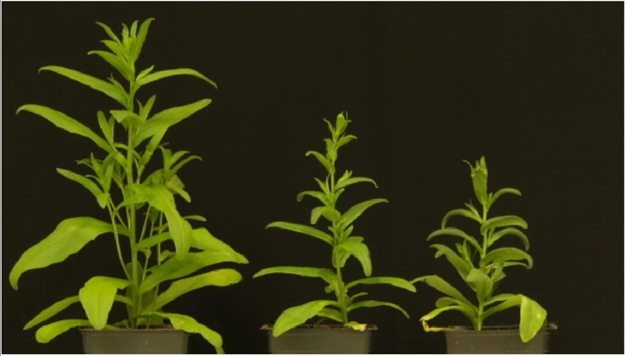Since we are located right next to the glistening water of the Oosterdok, there's no beating around the bush. All we have to do is turn on a waterpump and start replenishing the aquaponics system with the water from our canal, because the numbers don't lie. In aquaponics alone we use about a 100'000 L of tapwater each year, and if you add the water we need for the outdoor growbeds that are scattered around Dijkspark, this number easily doubles. With droughts that are becoming more common and more severe; the need to reduce our tapwater consumption is clear. So let's close the tap.
However, even though the thought that canalwater is overly dirty is a bit of a misconception, there are some things we need to take into account when we make the shift from fresh tapwater to canalwater. The biggest obstacle we anticipate is the fact that canal water is brackish, which means that the salinity level is higher compared to that of tap water. This will cause problems for plant growth. Higher salt levels can prevent the plants from taking up necessary nutrients and water, because the osmotic pressure of the water will be higher than the osmotic pressure in the plant cells (STOWA, 2022). As a result, plants will show symptoms of drought stress or reduced growth, even though they are irrigated with plenty of water (STOWA, 2022). The picture below shows the plant Camelina sativa watered with increasingly saline water. As can be seen, the plant shows reduced growth under saline conditions (Heydarian et al., 2018). Both in the aquaponics system and in conventional (soil based) gardening, salt levels will build up when brackish water is continuously added to the system. The effects of salinity will therefore become more severe as time passes.
Apart from higher salinity levels, we need to take into account that heavy metals and harmful microbes can be present in the water of the Oosterdok. Some heavy metals are harmful to plants, while others just accumulate in the plant tissue. The problem with heavy metals is that plants don't have a mechanism to get rid of them. This means that if high levels of heavy metals are present in the water, high levels will accumulate in the plant tissue, and if we eat the plants they will accumulate in our tissue as well. We don't expect these concentrations to be alarming (based on water quality research of Waternet), but we do take it seriously (Waternet, 2023; Marineterrein, 2022). The same goes for microbes like E. Coli. After heavy rainfall, higher concentrations of E. Coli can be present in the Oosterdok, because there is overflow of sewerage into the water (Deltares, 2017). Even though it is not always harmful to consume trace concentrations of E. Coli, researchers did find that disease causing strains of E. Coli can penetrate in plant cells and cause food poisoning (SGM, 2014). It is good to be aware of water quality parameters like these, so we can monitor the water we use and act accordingly.
The most exciting part of the project is to see how we can adapt to the specific properties of the water to grow a bigger appreciation of what the canal has to offer. Regarding the salinity problem, we are making a prognosis of the salinity increase in the aquaponics system, so we have an idea about when and what kind of actions we need to take. We can deal with the problem of increasing salinity in the following ways:
- Grow salt tolerant plants
- Monitor the salinity level of the canal to gain a better understanding about when to withdraw water from the canal
- Irrigate with a mix of rainwater and canalwater
- Flush the whole system with fresh water (either tapwater or rainwater)
- Possibly filtering the water
Relevance
This research is relevant for our own system specifically, but the outcomes are useful on a bigger scale as well. More and more people have an interest in saline agriculture, because there is a growing strain on freshwater sources. At this time only 2.5% of all water on earth is freshwater and 1.2% of freshwater is surface water, which serves most of life’s needs (National geographic, 2022). This amount is decreasing as sea level rise causes surface water to salinize. Apart from a shrinking freshwater supply, many farmers worldwide have to deal with soils that are degraded because of salt buildup. About 20-25% of agricultural soils are affected by saline conditions (Hop 2010; Hassani, 2021). More knowledge regarding adaptation strategies is therefore useful both on the local and the global scale.
Action plan
The coming growing season we will make the shift to irrigation with canal water. This shift on its own will be very easy. However, making sure the system keeps running smoothly will keep us plenty busy. We will be monitoring the reaction of the big variety of plants that we have at Dijkspark, and we will be experimenting with salt tolerant plant species. We will also send regular soil and water samples to the lab to track how quickly the system salinizes. The aquaponics system in particular is suitable for experiments like these, because it is very controlled. We can track what we add very precisely and measure the consequences shortly after. We have an extensive nutrient log in which the pH and nutrient levels of over 4 years have been tracked. This makes it easy to compare with the initial situation.
Apart from ensuring that our plants (and the fish) are healthy, we are also going to improve our rainwater collection setup and we will try to find a way to monitor and display the salinity of the canalwater in realtime (we will use the electrical conductivity as a measure of salinity). We are excited about the various experiments that will be part of this project and mostly we are curious about people's attitudes towards eating plants that are grown with a combination of canalwater and fish shit.
Waternet - This project is funded by Waterschap Amstel, Gooi en Vecht
Sources
Deltares (2017). Monitoring en modellering waterkwaliteit binnenhaven Marineterrein Amsterdam. Retrieved February 3, 2023 from https://www.marineterrein.nl/wp-content/uploads/2016/06/11201236-000-BGS-0004-r-Monitoring-en-modellering-waterkwaliteit-binnenhaven-Marineterrein-Amsterdam-DEF.pdf
Hassani, A. (2021). Global predictions of primary soil salinization under changing climate in the 21st century. Nature.
Heydarian, Z., Yu, M., Gruber, M. et al. (2018). Changes in gene expression in Camelina sativa roots and vegetative tissues in response to salinity stress. Sci Rep8, 9804, https://doi.org/10.1038/s41598-018-28204-4
Hop, M. (2010). Zouttolerantie van planten. Dendroflora, 2010(47), 43–72.
Marineterrein (2023). Hoe schoon is het water? Retrieved from https://www.marineterrein.nl/project/swimming-in-water/
National Geographic Society (2022). Earth’s Freshwater. Retrieved February 6, 2023, from https://education.nationalgeographic.org/resource/earths-fresh-water/
Society for General Microbiology (2014). Pathogenic E. coli binds to fresh vegetables. ScienceDaily. Retrieved February 3, 2023 from www.sciencedaily.com/releases/2014/04/140415203813.htm
STOWA (2022). Zouttolerantie van teelten. https://www.stowa.nl/deltafacts/zoetwatervoorziening/verzilting/zouttolerantie-van-teelten
Waternet (2023). Water in kaart. Retrieved from https://www.waternet.nl/ons-water/oppervlaktewater/water-in-kaart/

